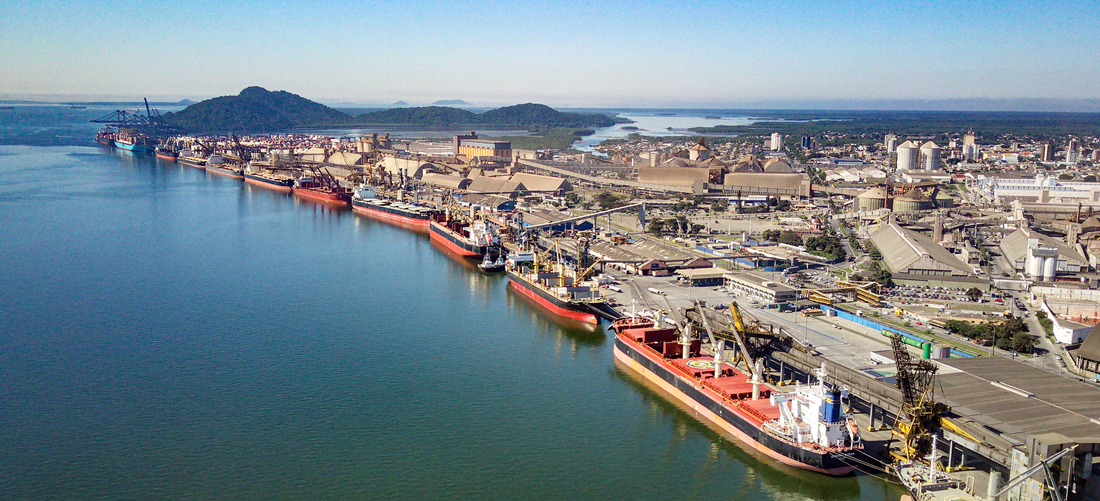
Brazil’s Waterborne Cargo Throughput Hits Record High of 1.32 Billion Tonnes in 2024
Feb, 19, 2025 Posted by Gabriel MalheirosWeek 202508
Brazil’s waterborne cargo throughput reached an all-time high in 2024, totaling 1.32 billion tonnes—a 1.18% increase compared to 2023. The past year also marked historic milestones for public ports and container throughput, according to the 2024 Waterborne Transport Performance report released Tuesday (18) by the National Waterway Transport Agency (ANTAQ).
Among the top commodities, wheat recorded a 39.51% surge (9.03 million tonnes), followed by liquefied petroleum gas (LPG), which increased by 35.31% (5.29 million tonnes), and fuels, oils, and mineral products, which rose by 23.63% (4.06 million tonnes).
The following chart reveals the top ten countries of origin for Brazilian wheat imports, according to data derived from Datamar’s DataLiner.
Top 10 Countries of Origin for Brazilian Wheat Imports | 2024 | WTMT
Source: DataLiner (click here to request a demo)
Prices
In December 2024 alone, Brazilian ports handled 103.53 million tonnes of cargo.
Sustained Growth in the Port Sector
The record-breaking cargo throughput reflects a sustained expansion in Brazil’s port sector, continuing a streak of consecutive annual records since 2019. Forecasts indicate continued growth in the coming years.
With 95% of Brazil’s exports shipped through ports, the steady rise in throughput over the past six years has significantly contributed to trade balance gains. In 2024, Brazil posted a trade surplus of $74.5 billion—the second-highest in recorded history.
Public Ports Set Record Throughput
Public ports achieved their highest cargo throughput since records began, handling 474.38 million tonnes—a 5.13% year-over-year increase. The best-performing ports were Santos, up 2.05%, Itaguaí, up 8.78%, and Paranaguá, up 1.65%.
Among the top 20 public ports, the Salvador Port posted the highest percentage growth, handling 6.6 million tonnes—an impressive 41.18% increase.
Containerized Cargo Hits New Milestone
Container throughput also reached a record high, totaling 153.3 million tonnes in 2024, a 20% increase compared to 2023.
Of this total, 105.01 million tonnes were moved via long-haul shipping, 46.76 million tonnes via cabotage, and 1.99 million tonnes through inland navigation and port support services. Notably, cabotage container volumes surged by 30.22% in the first half of the year compared to the previous year.
Breakbulk, Dry Bulk, and Liquid Bulk Cargo Trends
General cargo throughput reached 65.43 million tonnes, up 6.66%. Dry bulk cargo volume totaled 788.5 million tonnes, experiencing a slight dip (-0.25%), while liquid bulk cargo fell by 3.78% to 313.1 million tonnes.
Long-haul cargo throughput stood at 948.17 million tonnes, with cabotage accounting for 293.56 million tonnes and inland navigation handling 75.93 million tonnes.
Private Terminals Maintain Steady Performance
Private terminals maintained stable throughput levels compared to 2023, handling 845.98 million tonnes of cargo.
The highest cargo volume was recorded at the Ponta da Madeira Maritime Terminal, which moved 175.98 million tonnes—a 5.68% increase. The Porto Itapoá Terminais Portuários stood out among the top 20 private-use terminals (TUPs), registering a 16.03% increase, reaching 13.61 million tonnes.
Amazon River Drought Disrupts Navigation
A historic drought in the Amazon River during the second half of 2024 severely impacted navigability. To mitigate disruptions, ANTAQ authorized the use of the floating pier in Itacoatiara for transshipping containers to and from authorized terminals in the Amazon region. This measure helped sustain cargo flows within the region and across other Brazilian states.
Despite these efforts, inland navigation volumes declined by 4.7%, totaling 115.34 million tonnes—primarily due to low water levels in the Amazon and Madeira Rivers.
Given recurring drought conditions in Brazil and worldwide, ANTAQ has prioritized inland waterway concessions to ensure uninterrupted passenger and cargo transport in northern Brazil.
Current concession projects include the Paraguay River, which is at an advanced stage and will be the first to go to auction, and the Madeira River, where studies are being revised to account for extreme drought conditions.
Additionally, ANTAQ has officially launched studies for the Tapajós and Tocantins Rivers, while the Lagoa Mirim and Barra Norte projects remain high priorities.
Outlook for Port Throughput
ANTAQ has released projections for the coming years, forecasting a total cargo throughput of 1.33 billion tonnes in 2025, a 1.1% increase from 2024. The agency expects this upward trend to continue, with Brazil’s port sector handling an estimated 1.49 billion tonnes by 2029.
-
Ports and Terminals
Jun, 28, 2021
0
Brazilian feds have already siezed 2.3 tons of cocaine in Paranaguá this year
-
Ports and Terminals
Sep, 11, 2023
0
Port of Cabedelo launches capacity-enhancing dredging works
-
Economy
Nov, 01, 2023
0
New DataLiner Data: Brazilian Container Exports Decline, Imports Show Growth in September
-
Ports and Terminals
Jan, 03, 2025
0
Amazon Boosts Grain Exports with the Construction of 27 Grain Barges and Port Modernization

